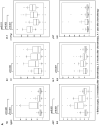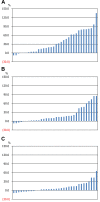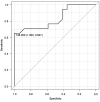Hyaluronic Acid May Be a Predictive Biomarker for Thrombocytopenia and Liver Dysfunction After Oxaliplatin-based Chemotherapy
- PMID: 35400001
- PMCID: PMC8962843
- DOI: 10.21873/cdp.10071
Hyaluronic Acid May Be a Predictive Biomarker for Thrombocytopenia and Liver Dysfunction After Oxaliplatin-based Chemotherapy
Abstract
Background/aim: Following oxaliplatin-based chemotherapy, approximately half of all colorectal cancer patients develop sinusoidal obstruction syndrome (SOS). SOS can be monitored by measuring splenic volume; however, obtaining this measurement is not a simple process. In this study, we evaluated changes in hyaluronic acid (HA) concentrations as a simpler marker of SOS.
Patients and methods: We measured splenic volume and laboratory data, including hyaluronic acid concentration, liver enzymes, and platelet counts, in 34 patients with colorectal cancer who underwent radical resection and who received capecitabine plus oxaliplatin (CapeOx) chemotherapy.
Results: A strong correlation was identified between ≥30% increase in splenic volume and significantly elevated HA concentrations. Affected patients also had persistent thrombocytopenia and liver dysfunction compared to patients without elevated HA concentration.
Conclusion: HA concentration may predict SOS in patients who receive CapeOx adjuvant chemotherapy.
Keywords: Hyaluronic acid; oxaliplatin; sinusoidal obstruction syndrome; splenic volume.
Copyright 2022, International Institute of Anticancer Research.
Conflict of interest statement
The Authors declare they have no financial or other conflicts of interest.
Figures







References
-
- Sargent DJ, Wieand HS, Haller DG, Gray R, Benedetti JK, Buyse M, Labianca R, Seitz JF, O'Callaghan CJ, Francini G, Grothey A, O'Connell M, Catalano PJ, Blanke CD, Kerr D, Green E, Wolmark N, Andre T, Goldberg RM, De Gramont A. Disease-free survival versus overall survival as a primary end point for adjuvant colon cancer studies: individual patient data from 20,898 patients on 18 randomized trials. J Clin Oncol. 2005;23(34):8664–8670. doi: 10.1200/JCO.2005.01.6071. - DOI - PubMed
-
- André T, de Gramont A, Vernerey D, Chibaudel B, Bonnetain F, Tijeras-Raballand A, Scriva A, Hickish T, Tabernero J, Van Laethem JL, Banzi M, Maartense E, Shmueli E, Carlsson GU, Scheithauer W, Papamichael D, Möehler M, Landolfi S, Demetter P, Colote S, Tournigand C, Louvet C, Duval A, Fléjou JF, de Gramont A. Adjuvant fluorouracil, leucovorin, and oxaliplatin in stage II to III colon cancer: Updated 10-year survival and outcomes according to BRAF mutation and mismatch repair status of the MOSAIC study. J Clin Oncol. 2015;33(35):4176–4187. doi: 10.1200/JCO.2015.63.4238. - DOI - PubMed
-
- Rubbia-Brandt L, Audard V, Sartoretti P, Roth AD, Brezault C, Le Charpentier M, Dousset B, Morel P, Soubrane O, Chaussade S, Mentha G, Terris B. Severe hepatic sinusoidal obstruction associated with oxaliplatin-based chemotherapy in patients with metastatic colorectal cancer. Ann Oncol. 2004;15(3):460–466. doi: 10.1093/annonc/mdh095. - DOI - PubMed
-
- Manfredi S, Lepage C, Hatem C, Coatmeur O, Faivre J, Bouvier AM. Epidemiology and management of liver metastases from colorectal cancer. Ann Surg. 2006;244(2):254–259. doi: 10.1097/01.sla.0000217629.94941.cf. - DOI - PMC - PubMed
LinkOut - more resources
Full Text Sources
